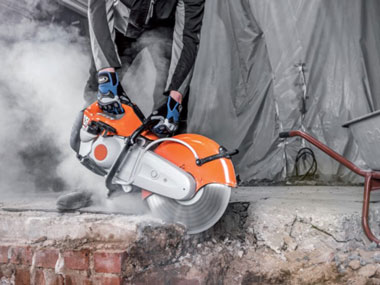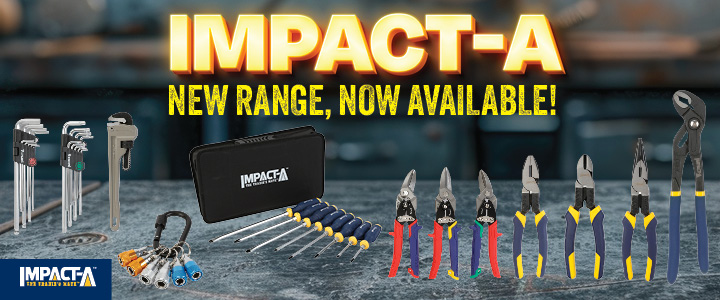Efficient, long-lasting and fast, diamond-cutting blades are designed to take on the toughest jobs.
By Frank Leggett
Diamond-cutting blades are specifically designed to cut particular materials such as granite, tiles, sandstone and bricks. Popular across all types of trades, they get the job done easily and quickly.
WHAT’S SO SPECIAL?
By utilising the correct diamond blade, the user has a faster, longer-lasting cutting blade than a reinforced abrasive wheel. The diamonds used on cutting blades are manufactured at high temperatures under high pressure.
Quality diamond blades have the diamond segments fixed with a laser welding process rather than just being pressed into the steel core.
“It’s a good idea to look for the Organisation for the Safety of Abrasives (oSa) symbol which ensures products are made to the highest standards in the world,” says Paul Hoye, managing director at Klingspor Australia. “The symbol also means that the manufacturer carries global product liability insurance.”
RIGHT BLADE FOR THE JOB
There’s no point beating around the bush—diamond blades are expensive. There is also a significant price difference between sintered and laser welded diamond blades. Choosing the correct diamond blade depends on the material to be cut and the needs of the user.
“A handyman with a small tiling or paving job may choose the cheaper sintered blade,” says Andrew Dowling, operations manager at Pferd Australia. “A tiling or paving contractor who uses the blades continually is likely to go for the laser welded type. In general, a quality laser welded diamond blade will give around 35 per cent more life than a quality sintered diamond blade.”
When deciding on the best option, turn to blade suppliers such as Klingspor, Pferd and Saint-Gobain. They provide guides and clear instructions that match blades to applications. “Norton Clipper brand blades use a colour-coding system on the packaging so the end user can quickly identify which blade they need to select,” says Matthew Redman, product manager at Saint-Gobain Abrasives.
TYPES OF BLADES
There are three types of diamond blades—segmented, continuous and turbo. Each has applications to which they are highly suitable and often they can be used in multiple situations. For example, slate can be cut with all three types of blades whereas ceramic tiles should only be cut with a continuous blade. Matching the right blade to the material is essential in ensuring a clean cut and a maximum life span for the blade.
Segmented:
This type of diamond blade is characterised by the deep cut-outs, or segments, around the edge. These allow air flow to cool the blade core and for debris to move away from the cut. That’s why this blade is often used for dry cutting. “Segmented blades result in the roughest cut,” says Andrew Dowling. “A segmented rim is perfect for concrete, brick, limestone and other hard or reinforced materials. Trying to use this type of blade on materials, such as tile, usually results in a chipped or low-quality finish.”
Continuous:
A continuous rim doesn’t contain segments or cut-outs. Generally, it’s only used for wet cutting as water cools the blade and removes debris from the cut. A continuous rim cuts slower but produces the highest quality cut. These blades are often used with granite, marble, ceramic tile and porcelain.
“Continuous rim blades are required for a good quality finish,” says Matthew Redman. “The flat continuous surface means there are no shocks against the material that could create chips. This type of blade is particularly suitable for tiles that need a perfect finish.”
Turbo:
The turbo is a segmented blade but with smaller cut-out segments. It can be used in wet or dry applications and often has small holes towards the inside of the blade to increase cooling. It gives a better finish than a segmented rim but won’t cut through the hardest materials.
“The turbo is a good all-rounder,” says Paul Hoye. “They are suitable for most materials but are not as aggressive as the segmented blade, or as smooth cutting as the continuous rim.”
BLADE SAFETY
An important point to remember is that diamond blades are sensitive to heat during the cutting process. Excessive heat can lead to segment loss, core warpage and cracking. Water as a coolant should be used whenever possible and dry cutting requires frequent stopping and free running to cool the blade.
All abrasive cutting must be performed with an emphasis on safety. All blades should be inspected thoroughly before starting to cut.
Appropriate PPE must be worn, including safety glasses, face shield, gloves, respiratory protection and safety boots. It’s also important that the speed of the power tool does not exceed the recommended safe speed of the wheel or blade. Never force the cut—use low pressure to avoid excessive heat generation and overloading the abrasive.
If you have any questions, don’t be afraid to ask. All abrasives salespeople can instruct you on the most suitable cutting blade to achieve the best possible result.






